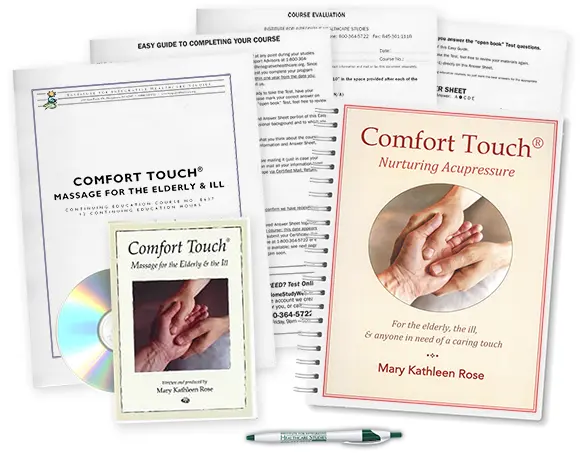Materials
- Video - 34 minutes
- Text - 185 pages
- Multiple-choice test
- Certificate upon completion
Description
Developed in 1989 by Mary Kathleen Rose through her work with hospice patients, the modality of Comfort Touch® enables you to bring the benefits of massage to the elderly and individuals suffering from chronic illness or injury. Through this continuing education program you'll learn the principles of Comfort Touch and gain a greater understanding of the physical and emotional needs of elderly, frail, and chronically ill clients. Through this program you will also:
- Define tactile receptors and the six principles of Comfort Touch.
- Identify the primary intention of Comfort Touch and how the elderly, frail and or ill clients can benefit from this modality including physical and psychosocial benefits.
- Discover how Comfort Touch is used as a complement to conventional medicine.
- List the physical and psychosocial issues and changes in functionality associated with aging and illness.
- Differentiate the various reasons for grieving and the primary phases in the grieving process.
- Recognize the roles and responsibilities for Comfort Touch practitioners including scope of practice, hygiene, Universal Precautions, confidentiality and documentation (including client intake).
- Identify cautions and considerations in the use of Comfort Touch with elderly and chronically ill massage clients.
- Observe the various client positions when performing Comfort Touch and body patterning for the practitioner.
- Observe the six guiding principles of Comfort Touch and the acronym SCRIBE (Slow, Comforting, Respectful, Into Center, Broad, Encompassing) and how they relate to specific application technique.
- Study the basic techniques of Comfort Touch and the importance of the awareness of anatomy, breathing and grounding, as well as sequences of a Comfort Touch session.
- Learn how to incorporate other modalities into Comfort Touch.
- Identify ways to adapt to the client's needs based on functionality as well as pain and discomfort.
- Determine Comfort Touch considerations for special populations including those with psychological issues and trauma, infants and children, pregnant and post-partum clients, medical/surgical patients, and clients with chronic and terminal illnesses.
- Outline how to communicate clearly and effectively with the client and their healthcare team both verbally and in writing.
- Review basic forms for documentation including client information and CARE notes.
- Evaluate the importance of self-care including proper sleep and rest, movement, exercise and nutrition as well as maintaining professional boundaries.
- Select appropriate settings for performing Comfort Touch and administration of Comfort Touch programs including funding programs, marketing and community outreach.
- Review Standard and Universal Precautions.
- Determine cautions and contraindications when integrating aromatherapy with Comfort Touch as well as the sensible use of scents in practice.
The course DVD provides you with visual training in the seated and supine positions as well as how to prepare for an at home visit.
Course Objectives
- Define tactile receptors and the six principles of Comfort Touch. Identify the primary intention of Comfort Touch and who can benefit from this modality including physical and psychosocial benefits.
- Discover how Comfort Touch is used as a complement to conventional medicine. List the physical and psychosocial issues and changes in functionality associated with aging and illness. Differentiate the various reasons for grieving and the primary phases in the grieving process.
- Recognize the roles and responsibilities for Comfort Touch practitioners including scope of practice, hygiene, Universal Precautions, confidentiality and documentation (including client intake).
- Identify cautions and considerations in the use of Comfort Touch. Observe the various client positions when performing Comfort Touch and body patterning for the practitioner.
- Observe the six guiding principles of Comfort Touch and the acronym SCRIBE (Slow, Comforting, Respectful, Into Center, Broad, Encompassing) and how they relate to specific application technique.
- Study the basic techniques of Comfort Touch and the importance of the awareness of anatomy, breathing and grounding, as well as sequences of a Comfort Touch session. Learn how to incorporate other modalities into Comfort Touch.
- Identify ways to adapt to the client’s needs based on functionality as well as pain and discomfort. Determine Comfort Touch considerations for special populations including those with psychological issues and trauma, infants and children, pregnant and post-partum clients, medical/surgical patients, and clients with chronic and terminal illnesses.
- Outline how to communicate clearly and effectively with the client and their healthcare team both verbally and in writing. Review basic forms for documentation including client information and CARE notes.
- Evaluate the importance of self-care including proper sleep and rest, movement, exercise and nutrition as well as maintaining professional boundaries.
- Select appropriate settings for performing Comfort Touch and administration of Comfort Touch programs including funding programs, marketing and community outreach.
- Review Standard and Universal Precautions. Determine cautions and contraindications when integrating aromatherapy with Comfort Touch as well as the sensible use of scents in practice.
- Review Comfort Touch principles, sequence of touch in the seated and supine positions, preparations for an at-home visit, and self-care for the practitioner.
Course Reviews
Jennifer Orman, LMT
3/14/2025
Rochele Clark, LMT
3/12/2025
Sonia Alexandra, LMT, BCTMB
3/7/2025
Catharina McGrath, LMT, BCTMB
2/21/2025
Lucia Chan
2/17/2025
Great detail in text and practice
Read more reviews
Instructors

Mary Kathleen Rose, BA, CMT
Mary Kathleen Rose is a certified massage therapist with over thirty years experience in the holistic health field. She graduated from the Boulder College of Massage Therapy in 1985 and has a B.A. in Integrative Heal-ing from Metropolitan State College of Denver. She has taught massage, career development, and wellness education at a number of different massage schools. She has served as a research consultant/trainer for a number of projects including National Institutes of Health funded studies: The effects of massage for people with spinal cord injuries; Massage for children, adolescents, and young adults with cancer; and teaching Com-fort Touch® to parents of children with sickle cell anemia.
Mary is the developer, author and instructor of Comfort Touch a nurturing style of acupressure appropriate for the elderly and the chronically and terminally ill.
Back to Top



